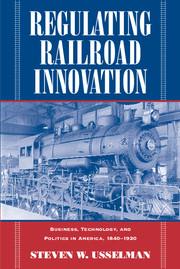Epilogue: The Enduring Challenge of Innovation
Published online by Cambridge University Press: 12 August 2009
Summary
The long odyssey of American railroading recounted in these pages has a ring of inevitability about it. Reaching the end of the story, one might readily be tempted to think of the industry in terms of the human life cycle. Railroading burst forth during the early nineteenth century like a young child, unformed but full of promise. After a tumultuous and extended struggle it emerged in something like middle age, its aspirations a bit trimmed, perhaps, but performing with a newfound efficiency derived from experience and from a more concerted focus. From there railroading grew steadily more rigid, less inclined to entertain new possibilities, and unwilling or unable to escape established patterns and summon the energy required to turn such visions into reality. Lingering long enough to see a new generation of promising technologies supplant it, railroading never came close to recapturing the blossom of its own youth.
This tidy portrait, though not entirely without basis, obscures a deeper truth. For while a history of railroad innovation may contain many elements of an unfolding tragic drama, it also highlights some remarkably persistent features of American society and culture. The issues Americans confronted in attempting to regulate railroad innovation have arisen time and again as new technologies emerged and evolved in the American context. The histories of telephony, electric power, highways, and networked computing, to cite some obvious examples, each resound with many of the same themes discussed in this book.
- Type
- Chapter
- Information
- Regulating Railroad InnovationBusiness, Technology, and Politics in America, 1840–1920, pp. 381 - 388Publisher: Cambridge University PressPrint publication year: 2002



